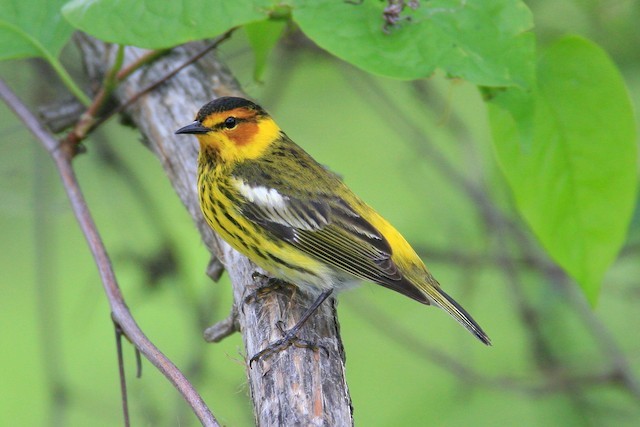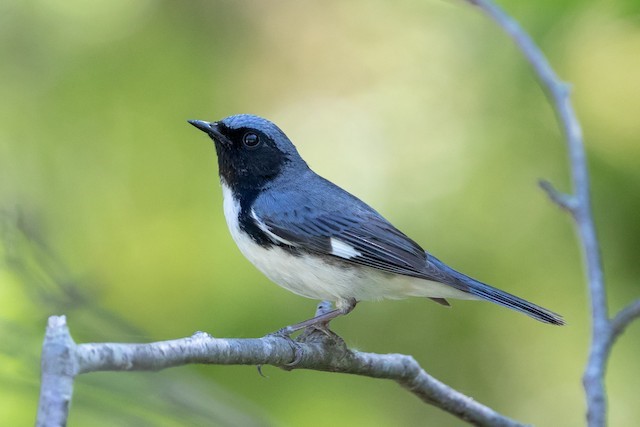Parulidae: Wood Warblers

Cape May Warbler. © Timothy Jones
The wood warblers are a New World family of songbirds best known for adding splashes of color to the lives of birdwatchers in eastern North America each spring. They are small, active insect-gleaners that specialize their foraging habits on certain niches in the forest or, in a few cases, open woodland, brush, swamps, and marshes. This specialization allows for many species to thrive in the same area without direct competition and as a result they are among the most diverse bird families in North America.

Prothonotary Warbler. © Tony Moline
Approximately half of wood warbler species breed in the temperate zone of North America, and about half of these in southeastern Canada and the northeastern U.S. Most of these species winter in the tropics, and comprise the emblematic group of Neotropical migrant songbirds, diverse in their appearances and susceptible to the impacts of habitat destruction on their breeding and wintering grounds and at some strategic stopover points. Some of these species—most prominently the Blackpoll Warbler (Setophaga striata)—fly nonstop for hundreds or thousands of miles over the open ocean, journeys that seem impossible for such small, delicate songbirds.

Black-throated Blue Warbler. © Cory Gregory
The Parulidae have long been recognized as a discrete branch of the nine-primaried songbird assemblage, though for several years they were formally relegated to subfamily status. A small number of anomalous species have sometimes been included in this family, but in each of these cases the current consensus is to place those outliers in other large families or elevate the anomalous species to family status.
Identification
Wood warblers in breeding plumage are readily identifiable by sight in most cases, but many nonbreeding plumages, especially immature females, are nondescript and easily confused with one another. A few species groups, such as the yellowthroats, consist of many similar species that are best identified by range, and can be essentially indistinguishable when they occur together.
Taxonomy
There are many unresolved issues in the internal taxonomy of wood warblers. Several of the traditionally recognized species include distinctive subspecies, and it is unclear how many of these are best regarded as separate species. In a few cases, traditionally recognized species regularly interbreed, producing identifiable hybrids. The total number of wood warbler species, as currently understood, is in the range of 118 to 153, plus one recently extinct.
Ovenbird (Seiurus aurocapilla)
Worm-eating Warbler (Helmitheros vermivorum)
Louisiana Waterthrush (Parkesia motacilla)
Northern Waterthrush (Parkesia noveboracensis)
Bachman’s Warbler (Vermivora bachmanii) †
Blue-winged Warbler (Vermivora cyanoptera)
Golden-winged Warbler (Vermivora chrysoptera)
Black-and-white Warbler (Mniotilta varia)
Prothonotary Warbler (Protonotaria citrea)
Swainson’s Warbler (Limnothlypis swainsonii)
Crescent-chested Warbler (Oreothlypis superciliosa)
Flame-throated Warbler (Oreothlypis gutturalis)
Tennessee Warbler (Leiothlypis peregrina)
Orange-crowned Warbler (Leiothlypis celata)
“Orange-crowned Warbler” (L. c. celata)
“Rocky Mountain Warbler” (L. c. orestera)
“Pacific-slope Warbler” (L. c. lutescens)
“Channel Islands Warbler” (L. c. sordida)
Colima Warbler (Leiothlypis crissalis)
Lucy’s Warbler (Leiothlypis luciae)
Nashville Warbler (Leiothlypis ruficapilla)
“Calaveras Warbler” (L. r. ridgwayi)
“Nashville Warbler” (L. r. ruficapilla)
Virginia’s Warbler (Leiothlypis virginiae)
Semper’s Warbler (Leucopeza semperi)
Connecticut Warbler (Oporornis agilis)
Gray-crowned Yellowthroat (Geothlypis poliocephala)
Chiriquí Yellowthroat (Geothlypis chiriquensis)
Masked Yellowthroat (Geothlypis aequinoctialis)
Black-lored Yellowthroat (Geothlypis auricularis)
Southern Yellowthroat (Geothlypis velata)
MacGillivray’s Warbler (Geothlypis tolmiei)
Mourning Warbler (Geothlypis philadelphia)
Kentucky Warbler (Geothlypis formosa)
Olive-crowned Yellowthroat (Geothlypis semiflava)
Black-polled Yellowthroat (Geothlypis speciosa)
Belding’s Yellowthroat (Geothlypis beldingi)
Bahama Yellowthroat (Geothlypis rostrata)
Altamira Yellowthroat (Geothlypis flavovelata)
Common Yellowthroat (Geothlypis trichas)
“Pacific Yellowthroat” (G. t. arizela)
“Western Yellowthroat” (G. t. occidentalis)
“Eastern Yellowthroat” (G. t. trichas)
“Brownsville Yellowthroat” (G. t. insperata)
“Chapala Yellowthroat” (G. t. chapalensis)
Hooded Yellowthroat (Geothlypis nelsoni)
Whistling Warbler (Catharopeza bishopi)
Plumbeous Warbler (Setophaga plumbea)
Elfin Woods Warbler (Setophaga angelae)
Arrowhead Warbler (Setophaga pharetra)
Hooded Warbler (Setophaga citrina)
American Redstart (Setophaga ruticilla)
Kirtland’s Warbler (Setophaga kirtlandii)
Cape May Warbler (Setophaga tigrina)
Cerulean Warbler (Setophaga cerulea)
Northern Parula (Setophaga americana)
Tropical Parula (Setophaga pitiayumi)
“Black-lored Parula” (S. p. nigrilora)
“West Mexican Parula” (S. p. pulchra)
“Trés Marías Parula” (S. p. insularis)
“Socorro Parula” (S. p. graysoni)
“Central American Parula” (S. p. inornata)
“Coiba Parula” (S. p. cirrha)
“Pacific Parula” (S. p. pacifica)
“Subtropical Parula” (S. p. alarum)
“Tropical Parula” (S. p. pitiayumi)
Magnolia Warbler (Setophaga magnolia)
Bay-breasted Warbler (Setophaga castanea)
Blackburnian Warbler (Setophaga fusca)
American Yellow Warbler (Setophaga petechia)
“Northern Yellow Warbler” (S. p. aestiva)
“Galápagos Warbler” (S. p. aureola)
“Mangrove Warbler” (S. p. erithachorides)
“Golden Warbler” (S. p. petechia)
“Martinique Warbler” (S. p. ruficapilla)
Chestnut-sided Warbler (Setophaga pensylvanica)
Blackpoll Warbler (Setophaga striata)
Black-throated Blue Warbler (Setophaga caerulescens)
Palm Warbler (Setophaga palmarum)
“Western Palm Warbler” (S. p. palmarum)
“Yellow Palm Warbler” (S. p. hypochrysea)
Olive-capped Warbler (Setophaga pityophila)
Pine Warbler (Setophaga pinus)
“Pine Warbler” (S. p. pinus)
“Hispaniolan Warbler” (S. p. chrysoleuca)
Myrtle Warbler (Setophaga coronata)
Audubon’s Warbler (Setophaga auduboni)
Goldman’s Warbler (Setophaga goldmani)
Yellow-throated Warbler (Setophaga dominica)
Bahama Warbler (Setophaga flavescens)
Vitelline Warbler (Setophaga vitellina)
Prairie Warbler (Setophaga discolor)
Adelaide’s Warbler (Setophaga adelaidae)
Barbuda Warbler (Setophaga subita)
St. Lucia Warbler (Setophaga delicata)
Grace’s Warbler (Setophaga graciae)
Black-throated Gray Warbler (Setophaga nigrescens)
Townsend’s Warbler (Setophaga townsendi)
Hermit Warbler (Setophaga occidentalis)
Golden-cheeked Warbler (Setophaga chrysoparia)
Black-throated Green Warbler (Setophaga virens)
Santa Marta Warbler (Myiothlypis basilica)
Citrine Warbler (Myiothlypis luteoviridis)
White-striped Warbler (Myiothlypis leucophrys)
Flavescent Warbler (Myiothlypis flaveola)
White-browed Warbler (Myiothlypis leucoblephara)
Pale-legged Warbler (Myiothlypis signata)
Black-crested Warbler (Myiothlypis nigrocristata)
Buff-rumped Warbler (Myiothlypis fulvicauda)
Riverbank Warbler (Myiothlypis rivularis)
“Guianan Warbler” (M. r. mesoleuca)
“Riverbank Warbler” (M. r. rivularis)
Two-banded Warbler (Myiothlypis bivittata)
Roraiman Warbler (Myiothlypis roraimae)
Chocó Warbler (Myiothlypis chlorophrys)
Cuzco Warbler (Myiothlypis chrysogaster)
Gray-throated Warbler (Myiothlypis cinereicollis)
White-lored Warbler (Myiothlypis conspicillata)
Gray-and-gold Warbler (Myiothlypis fraseri)
Russet-crowned Warbler (Myiothlypis coronata)
Gray-headed Warbler (Myiothlypis griseiceps)
Fan-tailed Warbler (Basileuterus lachrymosus)
Rufous-capped Warbler (Basileuterus rufifrons)
Chestnut-capped Warbler” (Basileuterus delattrii)
“Salvin’s Warbler” (B. d. salvini)
“Chestnut-capped Warbler” (B. d. delattrii)
Black-cheeked Warbler (Basileuterus melanogenys)
Pirre Warbler (Basileuterus ignotus)
Golden-browed Warbler (Setophaga belli)
Golden-crowned Warbler (Basileuterus culicivorus)
“Stripe-crowned Warbler” (B. c. culicivorus)
“Cabanis’s Warbler” (B. c. cabanisi)
“Golden-crowned Warbler” (B. c. auricapillus)
“White-bellied Warbler” (B. c. hypoleucus)
Black-eared Warbler (Basileuterus melanotis)
Tacarcuna Warbler (Basileuterus tacarcunae)
Three-banded Warbler (Basileuterus trifasciatus)
Yungas Warbler (Basileuterus punctipectus)
Three-striped Warbler (Basileuterus tristriatus)
“Daedalus Warbler” (B. t. daedalus)
“Colombian Warbler” (B. t. auricularis)
“Venezuelan Warbler” (B. t. meridanus)
“Paria Warbler” (B. t. pariae)
“Three-striped Warbler” (B. t. tristriatus)
Canada Warbler (Cardellina canadensis)
Wilson’s Warbler (Cardellina pusilla)
“Western Wilson’s Warbler” (C. p. pileolata)
“Pacific Wilson’s Warbler” (C. p. chryseola)
“Eastern Wilson’s Warbler” (C. p. pusilla)
Red-faced Warbler (Cardellina rubrifrons)
Red Warbler (Cardellina rubra)
“Gray-cheeked Red Warbler” (C. r. melanauris)
“White-cheeked Red Warbler” (C. r. rubra)
Pink-headed Warbler (Cardellina versicolor)
Painted Redstart (Myioborus pictus)
Slate-throated Redstart (Myioborus miniatus)
Brown-capped Redstart (Myioborus brunniceps)
Yellow-crowned Redstart (Myioborus flavivertex)
White-fronted Redstart (Myioborus albifrons)
Golden-fronted Redstart (Myioborus ornatus)
Spectacled Redstart (Myioborus melanocephalus)
Collared Redstart (Myioborus torquatus)
Paria Redstart (Myioborus pariae)
White-faced Redstart (Myioborus albifacies)
Guaiquinima Redstart (Myioborus cardonai)
Tepui Redstart (Myioborus castaneocapilla)
References
Curson, J., D. Quinn, and D. Beadle. 1994. Warblers of the Americas: An Identification Guide. Houghton Mifflin, Boston.
Dunn, J. L., and K. L. Garrett. 1997. A Field Guide to Warblers of North America. Houghton Mifflin, Boston.
Hume, J.P. 2017. Extinct Birds (Second Edition). Bloomsbury Publishing PLC, London.
Roberson, D. 2005. Bird Families of the World: New World Warblers: Parulidae, http://creagrus.home.montereybay.com/parulids.html. (Posted October 21, 2005. Accessed March 14, 2019.)